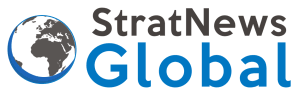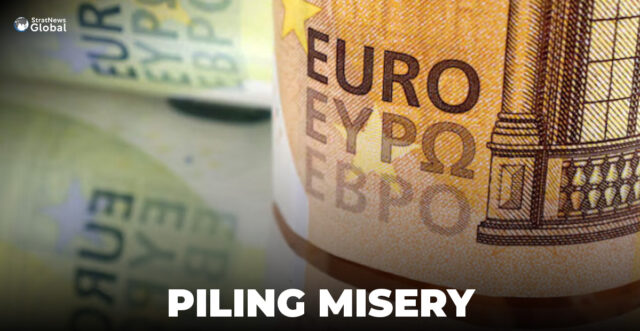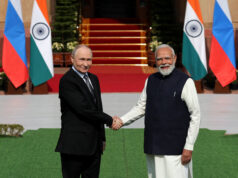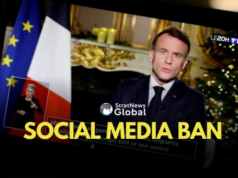The euro has unexpectedly surged following U.S. President Donald Trump’s major tariffs announcement, an outcome that could trim at least a few percentage points from European corporate earnings, compounding the direct impact of the tariffs.
While economists usually expect countries’ currencies to weaken when hit by tariffs, limiting the damage somewhat, the opposite has happened since Trump’s April 2 bombshell triggered market chaos and sent the safe-haven dollar tumbling.
10% Growth
The euro, also lifted by a seismic shift in Germany towards heavy spending, has climbed about 10% since the start of March and touched a record high on a trade-weighted basis, a key metric for the European Central Bank. Half of that gain has come in April, putting the currency on track for its strongest month since late 2022 .
That’s bad news for the bloc’s export-reliant economy, however, where companies in the STOXX 600 index derive 60% of their revenues from abroad, of which the U.S. accounts for nearly half, Goldman Sachs estimates.
“If you have much weaker growth and a much stronger euro, that’s a bit of a double whammy for Europe,” said Emmanuel Cau, head of European equities strategy at Barclays.
Historically, a sustained 10% rise in the euro shaves 2-3% off corporate earnings, said BNP Paribas chief equity strategist Dennis Jose. That will only add to the uncertainty with tariffs already weighing on the first-quarter earnings outlook.
Export heavyweight Germany, the bloc’s biggest economy, could suffer ‘a slight recession’; in 2025, Bundesbank President Joachim Nagel said last week, while the International Monetary Fund has cut its growth forecast for the bloc as a whole for this year and next.
Deeper Pain
With some banks expecting the euro to rise to $1.20 this year, the pain could be deeper, and companies are already ringing alarm bells in their first-quarter earnings commentary.
Even before the latest leg of euro strength, Unilever’s first-quarter turnover declined as currency impact helped offset sales growth.
Europe’s most valuable company SAP predicts that for every 1 cent rise in the euro, its annual revenue could decline by around 30 million euros ($34.05 million).
L’Oreal estimated that sustaining the $1.15 level the euro touched last week for the full year could knock as much as 2.9% off its net sales.
‘Less Demand’
For companies the risk also dents their competitiveness, where the bloc desperately needed a boost even before all the tariff-related turmoil.
“We’re an exporting continent, and what it means is that net -net you will see less demand,” said ING’s chief economist Marieke Blom.
She expects euro zone growth to suffer even as the strength of the currency supports consumers, lowering costs for imports including energy.
One big weak spot is automakers. Cars are a key European export, and they faced pressure from Chinese competitors even before they were hit by an additional U.S. tariff.
Since Trump’s inauguration, European auto and part stocks have slumped some 8%, compared with a less than 1% fall in the STOXX 600.
Investors in European equities already spooked by tariffs said currency strength was another reason for caution.
Frederique Carrier, RBC Wealth Management’s head of investment strategy in the British Isles and Asia, prefers domestically focused European stocks and those that stand to gain from German stimulus.
Hedging Challenge
Adding to Europe Inc’s problems, it is unclear how far companies can protect themselves from currency swings as they usually do by using derivatives.
SAP told analysts much of its free cashflow was hedged at a higher exchange rate, so it would take the real hit in 2026 when those hedges expire.
Jackie Bowie, head of EMEA at risk management firm Chatham Financial, said corporate hedging activity has increased this year but that had slowed recently with clients concerned they may end up locking in a worse rate given the speed of the dollar’s recent fall.
Corporates may also want to hedge for longer, but that is risky as tariffs could quickly change the geographical exposure of their sales as well as production, she said.
Most companies use the forwards market to hedge their currency exposures, while bigger firms also use options.
Selling Volatility
One popular options strategy, so-called selling volatility, where companies receive payouts when currencies move within a narrow range, has come to a halt in the last six weeks given all the market swings, said Nomura FX options trader Aadith Raman, while typically accounting for around 25% of FX hedges for users.
Nomura is advising companies to increase their use of options given uncertainty around future cashflows, Raman added, as they can structure trades allowing them to buy or sell more euros than initially expected.
“The last six weeks have been unprecedented… so people are acting very cautiously,” Raman said.
($1 = 0.8810 euros)
(With inputs from Reuters)





